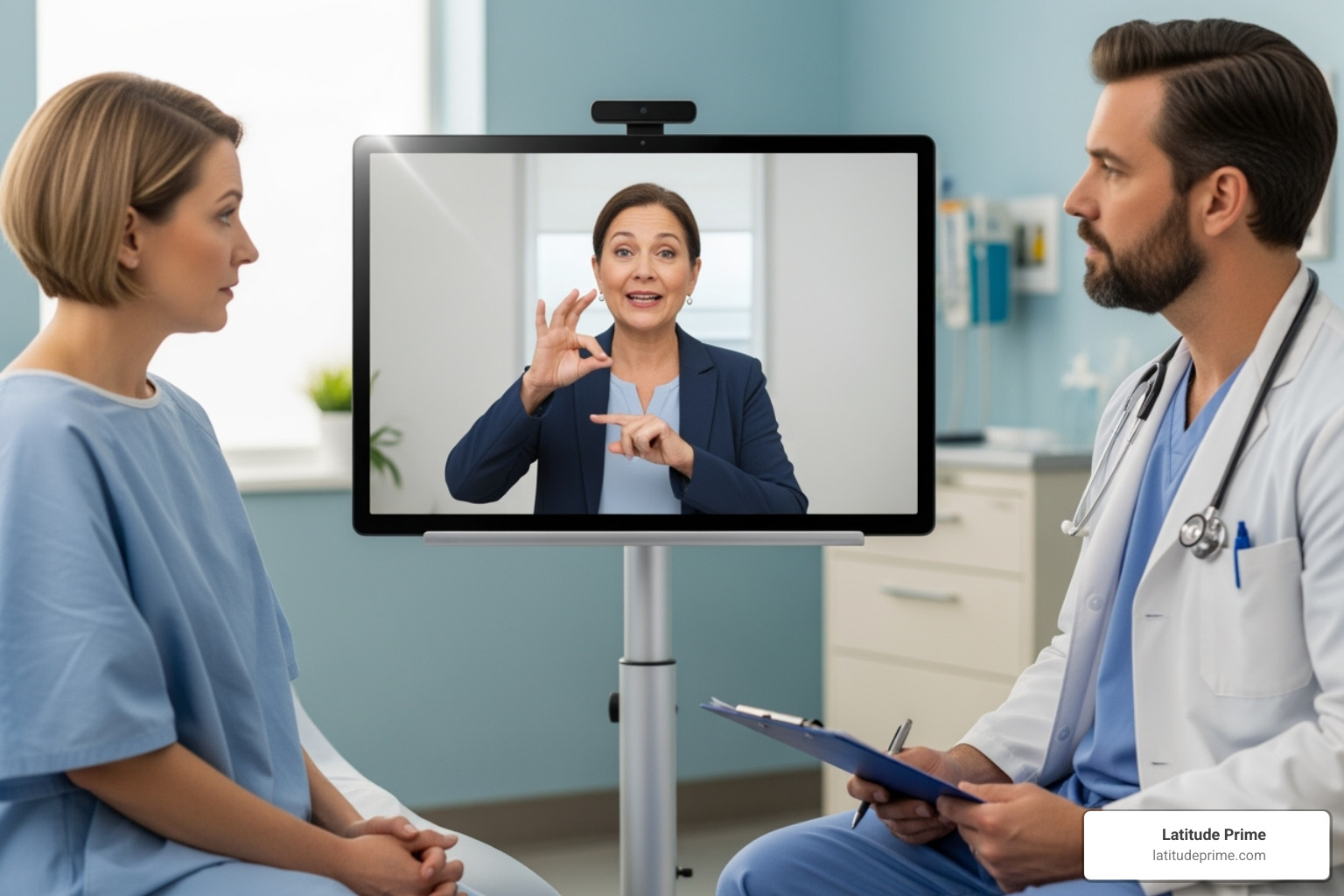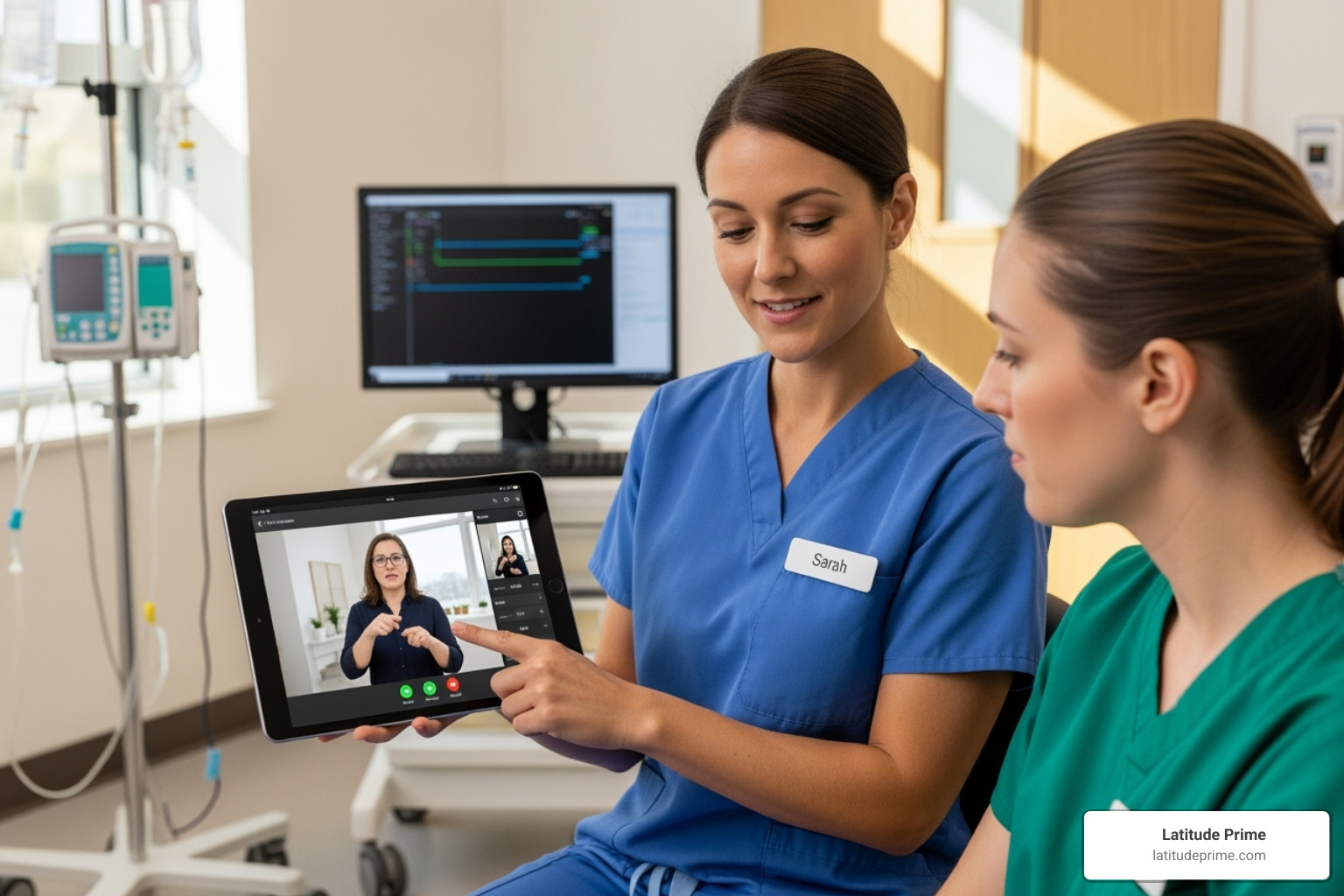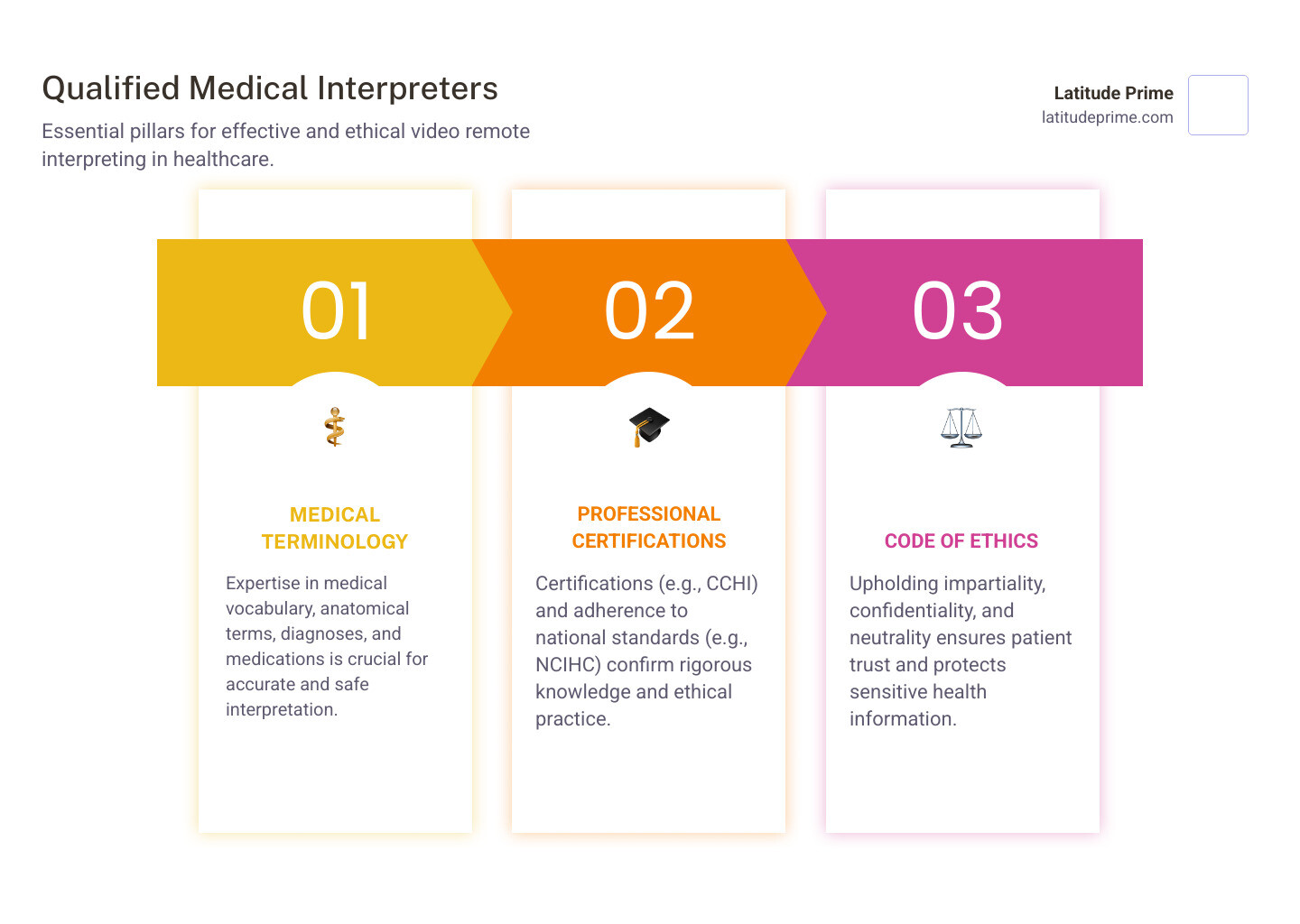Video Remote Interpreting Healthcare: 1 Essential Guide
Why Language Barriers in Healthcare Demand Immediate Solutions
Video remote interpreting healthcare is a telehealth technology that connects patients, healthcare providers, and professional interpreters in real-time through secure video conferencing. It enables immediate, face-to-face communication for patients with Limited English Proficiency (LEP) or who are Deaf or Hard of Hearing (DHH), ensuring they receive equitable care in their preferred language.
Key Facts About VRI in Healthcare:
- What it is: Real-time interpretation via video call, connecting an off-site interpreter with patient and provider
- Who it serves: LEP patients needing language access and DHH patients requiring sign language interpretation (ASL, BSL)
- Primary benefits: Instant connection (often under 30 seconds), visual communication for non-verbal cues, cost savings compared to on-site interpreters
- Common uses: Emergency care, routine appointments, mental health counseling, discharge instructions
- Technology required: Tablet, smartphone, or computer with camera and stable internet connection
Language barriers create serious healthcare risks. Patients with LEP experience poorer quality care, have less access to preventive services, and are less likely to follow treatment plans. The stakes are even higher for the Deaf and Hard of Hearing community—studies show higher mortality rates among Deaf patients compared to hearing patients.
VRI technology bridges this critical gap. By providing immediate access to qualified medical interpreters through video, healthcare facilities can ensure every patient receives care they can understand, regardless of the language they speak or whether they can hear.
This guide explores how VRI works, when to use it, how it compares to other interpretation methods, and how to implement it successfully in your facility while meeting regulatory requirements.

What is VRI and How Does it Transform Patient Communication?
Think of video remote interpreting healthcare as having a professional interpreter on call 24/7. When needed, a provider uses a tablet or computer to start a video call, connecting to a qualified interpreter within seconds. The interpreter sees and hears both the patient and provider, facilitating a real-time conversation in one of hundreds of languages.
The power of VRI lies in its visual component. Unlike phone interpretation, everyone can see each other, allowing the interpreter to catch crucial non-verbal cues like a wince of pain or a nod of understanding. This visual context is vital in healthcare, where a misunderstood symptom can have serious consequences.
This technology fundamentally improves patient outcomes. When patients understand their diagnosis and treatment plan, they are more likely to follow it. This leads to better diagnostic accuracy, fewer medical errors, and more effective care. For providers, VRI streamlines workflows by eliminating the need to schedule or wait for an on-site interpreter. Learn more about how our interpretation services can support your facility.
Key Benefits for Providers and Patients
The advantages of video remote interpreting healthcare improve care quality, efficiency, and satisfaction.
Speed makes all the difference. With connection times typically under 30 seconds, VRI provides instant access to a medical interpreter in emergencies, allowing treatment to begin without dangerous delays.
The cost savings are substantial. VRI uses a per-minute billing model, eliminating the travel fees, mileage charges, and minimum booking times associated with in-person interpreters. You pay only for the time you use.
Access to rare languages becomes possible. VRI connects you to a global network of interpreters, ensuring that patients speaking less common languages (e.g., Hmong, Karen) or needing specific sign languages (ASL, BSL) receive professional assistance.
Patient satisfaction soars when people feel understood. The visual component of VRI builds trust and rapport, as patients can see the interpreter’s facial expressions. This visual context also helps providers observe patient reactions, leading to more accurate diagnoses.
Breaking Down Barriers for LEP and DHH Patients
For patients with Limited English Proficiency (LEP) and those who are Deaf or Hard of Hearing (DHH), video remote interpreting healthcare is the key to equitable care.

LEP patients often face poorer health outcomes due to communication gaps. VRI connects them with professional medical interpreters who can accurately convey complex information, ensuring patients genuinely understand their condition and care plan.
For the DHH community, VRI is essential. Sign languages like ASL are visual and cannot be conveyed over the phone. The visual nature of VRI is the perfect solution, allowing DHH patients to communicate clearly with qualified sign language interpreters. The stakes are high; research published in the American Journal of Audiology found higher mortality rates among Deaf individuals, highlighting the life-threatening impact of communication barriers.
Our interpreters also bring cultural competency, understanding the beliefs and customs that shape a patient’s view of health. This awareness, combined with clear communication, is vital for securing informed consent, protecting patient autonomy, and reducing health disparities.
VRI vs. Other Language Services: A Comparative Look
Healthcare facilities have three main options for language services: Video Remote Interpreting (VRI), Over-the-Phone Interpreting (OPI), and On-Site Interpreting. Understanding the strengths of each helps optimize both patient care and budget.
Video remote interpreting healthcare offers a balance of immediacy and visual richness. OPI provides the fastest audio-only access, ideal for quick questions or scheduling. On-site interpreting, though the most expensive and requiring advance booking, remains the gold standard for long, sensitive conversations where a physical presence is preferred. Learn more about when in-person services work best on our on-site interpretation services page.
Here’s how these three stack up:
| Feature | Video Remote Interpreting (VRI) | Over-the-Phone Interpreting (OPI) | On-Site Interpreting |
|---|---|---|---|
| Cost | Economical; per-minute billing, no travel costs. | Very economical; per-minute billing, no travel costs. | Most expensive; includes travel, minimum booking fees. |
| Speed | Instant connection, often under 30 seconds. | Instant connection, often under 30 seconds. | Requires scheduling, travel time, potential delays. |
| Visual Context | Full visual cues (facial expressions, body language, sign language). | None; audio-only. | Full visual cues; in-person interaction. |
| Availability | 24/7, wide access to interpreters, including specialized languages. | 24/7, widest access to interpreters, including rare languages. | Limited by local availability and scheduling. |
| Ideal Use Cases | Visual cues important (DHH, complex discussions), urgent, remote areas. | Quick questions, less visual need, telephonic consultations. | Complex, sensitive, long sessions, patient preference. |
VRI is particularly powerful when visual cues are needed but waiting for an on-site interpreter isn’t feasible, such as in mental health sessions or consultations with DHH patients.
Key Features of Modern VRI Platforms
Modern video remote interpreting healthcare platforms are sophisticated tools built for the demands of healthcare.
- High-Quality Video and Audio: Crystal-clear transmission is essential for interpreting both spoken and sign languages accurately.
- HIPAA-Compliant Security: Platforms must use end-to-end encryption, VPNs, and strict access controls to protect sensitive patient data.
- Multi-Language Support: Top platforms offer video interpretation in dozens of languages and audio in hundreds more. Latitude Prime provides interpretation in over 300 languages.
- 24/7 Availability: Interpreters are on-demand around the clock to ensure language barriers never delay critical care.
- Device Compatibility: Services work on tablets, smartphones, laptops, and specialized carts, offering flexibility.
- User-Friendly Interface: Staff must be able to connect with an interpreter in seconds with minimal clicks and training.
- Data Reporting: Usage tracking helps facilities monitor connection times, evaluate performance, and optimize their program.
Cost-Effectiveness and Economic Benefits
Implementing video remote interpreting healthcare delivers significant financial benefits.
The most direct savings come from eliminating travel costs and using a per-minute billing model. Instead of paying for a two-hour minimum for a 15-minute consultation, you pay only for the time used.
These efficiencies lead to operational improvements, such as shorter patient wait times and smoother appointment flows. Better communication also contributes to long-term benefits like lower readmission rates. When patients fully understand discharge instructions and medication schedules, they are more likely to adhere to their care plan, preventing complications and costly repeat visits.
Best Practices for Implementing VRI in Your Facility
Successful video remote interpreting healthcare implementation requires weaving the technology into your daily care processes. A thoughtful rollout ensures VRI becomes a reliable and seamless tool for your team.

Success starts with a solid foundation:
- Staff Training: Provide hands-on practice so staff can confidently initiate calls, select languages, and position the device before they are with a patient.
- Technology Setup: A high-speed, reliable internet connection is the backbone of VRI. Test connectivity in all areas where the service will be used, from exam rooms to the ER.
- Equipment Placement: Position the device so the patient and provider can clearly see the interpreter, and vice-versa. For sign language, this means an unobstructed view of the interpreter’s face, hands, and upper body.
- Workflow Integration: Build language access into your standard procedures. Add “check language needs” to your intake process and keep devices charged and accessible.
- Patient Education: Briefly explain how VRI works to new users to ease anxiety and help them feel comfortable with the technology.
Overcoming Potential VRI Challenges
While VRI is powerful, it’s important to anticipate and prevent common challenges.
- Technical Issues: A frozen screen or poor audio can erode patient trust. Prevent this by investing in a robust VRI platform and ensuring you have sufficient internet bandwidth.
- Patient Dissatisfaction: Some patients may prefer an in-person interpreter for sensitive or complex discussions. A study on Deaf patients’ VRI experiences found that many were dissatisfied with service quality. Always respect patient preference and offer alternatives when possible.
- Interpreter Quality: An interpreter lacking medical terminology or cultural awareness can cause dangerous misunderstandings. Partner with a provider that uses qualified, certified medical interpreters (e.g., CCHI, NBCMI).
- Privacy Concerns: Patients need assurance that their conversations are confidential. Choose a fully HIPAA-compliant VRI provider that uses encrypted connections and whose interpreters adhere to a strict code of ethics.
For more insights, explore our page on interpreter health and social care.
Effective Communication Using video remote interpreting in healthcare
How you interact through the interpreter is as important as the technology itself.
- Speak directly to the patient, not the interpreter. Maintain eye contact with the patient to preserve the provider-patient relationship.
- Ensure a clear line of sight for everyone. The patient must be able to see the interpreter clearly, especially for sign language.
- Pause frequently to allow time for interpretation. Speak in short, complete sentences.
- Use plain language and avoid jargon when possible. If you must use a technical term, explain it.
- Confirm understanding with open-ended, teach-back questions like, “To make sure I was clear, can you tell me how you will take this medication?”
For more on this topic, explore our resources on cross-cultural communication.
Ensuring Compliance and Quality with Video Remote Interpreting in Healthcare
Implementing video remote interpreting healthcare requires strict adherence to legal and quality standards. As a language services provider, we understand that compliance is a legal and ethical imperative.
Healthcare facilities receiving federal funds must follow language access laws stemming from Section 504 of the Rehabilitation Act, the Americans with Disabilities Act (ADA), and Section 1557 of the Affordable Care Act (ACA). These laws protect every patient’s right to receive care in a language and format they understand. Ignoring these mandates can lead to legal penalties and compromised patient safety. For more on interpreter standards, visit our page on interpreter health and social care.
Meeting Regulatory Requirements (HIPAA, ADA)
Navigating the regulatory landscape is paramount. Two key regulations, HIPAA and the ADA, directly impact VRI services.
The Health Insurance Portability and Accountability Act (HIPAA) demands robust patient data security. VRI platforms must use secure, encrypted connections and strict access controls to protect all Protected Health Information (PHI).
The Americans with Disabilities Act (ADA) mandates effective communication for individuals with disabilities, including those who are Deaf or Hard of Hearing. VRI is a recognized auxiliary aid, but the service must meet technical requirements: real-time, full-motion video and audio over a high-speed connection. According to ADA guidance on effective communication, VRI should not be used if the technology is insufficient or the patient cannot see the screen.

Section 1557 of the ACA also prohibits discrimination by requiring language assistance for LEP individuals and effective communication for individuals with disabilities. Our VRI solutions help healthcare systems comply with these federal laws, ensuring equitable access to care.
The Importance of Qualified Medical Interpreters
The effectiveness of video remote interpreting healthcare hinges on the quality of its interpreters. A VRI platform is only as good as the human connection it facilitates.
Qualified medical interpreters must have:
- Medical Terminology Proficiency: A deep understanding of medical concepts is essential to convey information accurately and prevent errors.
- Professional Certifications: Credentials from organizations like the Certification Commission for Healthcare Interpreters (CCHI) or adherence to the National Council on Interpreting in Health Care (NCIHC) standards demonstrate a commitment to quality and ethics.
- Adherence to a Code of Ethics: Interpreters must follow principles of impartiality (remaining neutral) and confidentiality (keeping all patient information private).

At Latitude Prime, we thoroughly vet all medical interpreters to ensure they meet high professional standards, including annual HIPAA training. This rigorous approach guarantees that our interpreters are skilled professionals dedicated to facilitating accurate and ethical communication. For more details, refer to the National standards for healthcare interpreters.
Frequently Asked Questions about VRI in Healthcare
Is VRI appropriate for every medical situation?
While video remote interpreting healthcare is highly versatile, it may not be ideal for every situation. The choice between VRI and an in-person interpreter depends on the context, complexity, and patient’s preference.
- Emergency situations: VRI is invaluable for immediate access when an on-site interpreter isn’t available.
- Complex or sensitive conversations: For lengthy diagnoses, end-of-life discussions, or some mental health appointments, an in-person interpreter may be preferred to build rapport and avoid technical distractions.
- Patient preference: This should always be a guiding factor. If a patient is uncomfortable with VRI or the quality is poor, an alternative should be found to ensure patient-centered care.
What are the basic technical requirements for VRI?
Successful video remote interpreting healthcare relies on a few key technical components:
- Stable Internet Bandwidth: A high-speed connection is critical to transmit clear, real-time video and audio without lag.
- Quality Devices: A tablet, laptop, or VRI cart must have a high-quality camera, a clear microphone, and a screen large enough for the patient to see the interpreter clearly, which is especially important for sign language.
- A Secure Network: The platform must be HIPAA-compliant, operating over an encrypted network to protect patient confidentiality.
- Platform Compatibility: The VRI solution should integrate smoothly into existing workflows, whether through a dedicated app or integration with your EHR system.
How do you measure the success of a VRI program?
Measuring the success of a video remote interpreting healthcare program goes beyond usage numbers to assess its real-world impact.
Key metrics include:
- Patient and Provider Satisfaction: Use surveys to gauge whether patients felt understood and if providers found the system easy to use and effective.
- Interpreter Connection Times: Tracking how quickly interpreters connect is a direct measure of the system’s efficiency and reliability.
- Reduction in Communication-Related Errors: While harder to track, improved communication should lead to better treatment adherence and fewer adverse events.
- Cost Savings: Compare VRI expenses to the costs of on-site interpretation (including travel and minimums) to demonstrate a clear return on investment.

By monitoring these metrics, you can ensure your VRI program is efficient, compliant, and genuinely improving the quality of care.
Conclusion: The Future of Equitable Healthcare Communication
Video remote interpreting healthcare is more than a technology; it’s a fundamental tool for building a more equitable healthcare system. By giving patients the ability to understand their diagnosis, ask questions, and make informed decisions, we build trust and improve outcomes.
VRI transforms a frightening scenario—being unable to communicate with caregivers—into one where help is seconds away. It bridges language gaps for both LEP and DHH patients with an immediacy and visual clarity that was previously impossible.
Beyond translation, VRI’s role in modernizing healthcare is about:
- Efficiency: Connecting to interpreters in under 30 seconds.
- Economics: Saving on travel costs and minimum booking fees.
- Equity: Removing language barriers that contribute to health disparities.
Of course, technology alone isn’t enough. Success depends on qualified medical interpreters, HIPAA-compliant platforms, and thoughtful implementation. Choosing the right language services partner is critical.
At Latitude Prime, we share your commitment to patient care. Our ISO-certified services, proprietary PrimeCheck™ Quality Management System, and diverse certifications (WBE, MBE, SBA 8(a), HUBZone) reflect our dedication to excellence. We offer interpretation in over 300 languages, provided by trained medical professionals who understand the stakes of every conversation.
If you’re ready to transform how your facility communicates, we’re ready to help. The future of equitable healthcare is here. To explore how our services can improve outcomes at your facility, we invite you to learn more about medical and healthcare interpretation services.
Ready to empower your healthcare team with seamless, compliant, and compassionate language access?
https://latitudeprime.com/industries/medical-healthcare-translation-interpretation-services/



